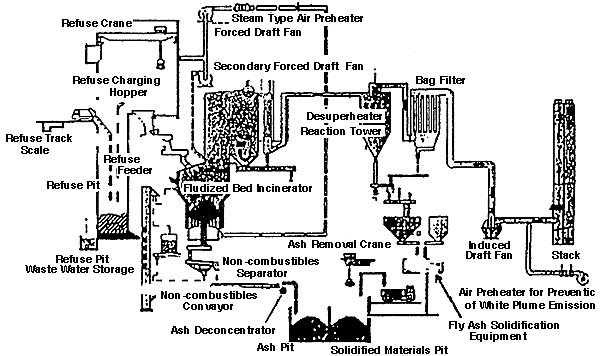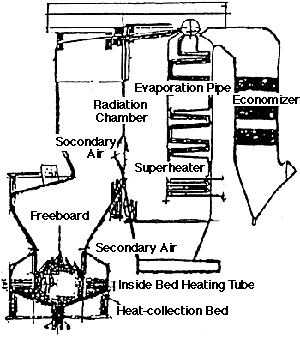Waste Treatment Technology in JAPAN
Drying, Incineration and Melting
(2) Stable combustion has been assured due to the employment of
Kawasaki's own refuse feeder and combustion control (fuzzy and Al
controls) design.
The inside bed is divided into the combustion bed and the heat-collection bed. This system more more positively collects heat from the fluidized bed. The following shows features of this system:
Fig.2 Fluidized Bed Incinerator for RDF
(2) Power generation capability will be enhanced since heat is collected by the
inside bed heating tube to cool down the fluidized bed.
Currently, we are implementing our plan with the steam condition of
85kg/cm2 X 500°C and generation efficiency of 30% or more.
In the case of the facility with the capacity of 280t/day at N-plant, power of lO,OOOkW is generated for utilities of the plant. When no power generation is required, the waste heat is utilized to send steam to the plant or to drive auxiliary equipment.
1. General
Generally, the refuse incineration plant is classified into the stoker type and the fluidized bed type. With the fluidized bed incinerator, refuse are first charged into the heated sand bed, where they are intensely mixed and stirred with the pre-heated air, and they are burned by the heat in quite a short period of time. Finally, the refuse are sent to the freeboard section to complete the combustion. The features of this type of incineration system includes even combustion, quick disposal of incombustible materials, and quick starting and stopping of the system. Owing to these excellent characteristics, the fluidized bed incineration systems have been positively employed in various operations relating to disposal of versatile industrial wastes, sludge, plastics as well as municipal refuse. The following is the outline of Kawasaki Fluidized Bed Incineration System.
2. Fluidized Bed Incineration System for Municipal Solid Waste
A concept drawing of the system is shown in the figure-l. Since the nature of municipal refuse is diversified, the most indispensable factor is to secure stable combustion. The following are our technical features in this aspects:
(1) High durability has been assured because the furnace and the boiler
are integrated.
Fig 1 Plant Flow Sheet

3. Fluidized Bed Incinerator for RDF
The right-hand figure shows the concept drawing of the fluidized bed incinerator for RDF, which offers higher temperature and pressure to secure quality steam condition based on the municipal refuse fuel.

(1) Since the concentration of corrosive gas HCI is sufficiently low within
the bed, high-temperature and high-pressure steam can easily be obtained
by installing a superheater within the bed.
4. Fluidized Bed Incinerator System for Industrial Solid Waste.
Fluidized Bed Incinerator System is also applied for the disposal of Industrial Solid Waste such as sludge and pulp sludge.
1-1 Higashikawasaki-cho 3 chome Chuo-ku Kobe 650-91 Japan
Tel : +81-78-360-8653 Fax : +81-78-360-8661